Poultry & egg farm confined spaces
Because of toxic gases and other hazards, working in confined spaces on poultry and egg farms can be dangerous. It is important to fully understand the hazards before entering the space.
The hazards
Below, you'll find general information to help you assess the hazards of confined spaces on poultry and egg farms. Please note: there may be confined spaces on your farm that are not listed here.
Normally, storing feed in bins for animal consumption does not produce toxic gases. However, if the moisture content is too high, feed may ferment. Then, toxic gases can build up and replace oxygen in the air. Before entering the bin, consider any previous use of pesticides or fumigants, or possibly mould.
When the moisture content is high, feed will not flow smoothly. Sometimes, bridges or shoulders may form in large bins creating a hazard that will engulf (or surround) a worker. Workers may also be struck by fragments of bridges and hang-ups.
| Hazards | Hazardous work |
|
|
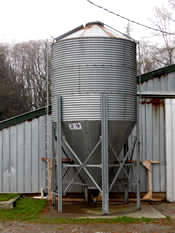
Feed bin
Poultry and egg farms in rural areas aren't part of municipal sanitary collection systems. These operations must have stand-alone sewage treatment facilities, including collection and processing chambers.
In these confined spaces, wastewater treatment can result in low-oxygen conditions and produce toxic gases. Inhaling these toxic gases at high concentrations can quickly cause death.
| Hazards | Hazardous work |
|
|
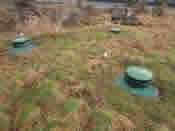
Hatches on septic tanks
Sumps are below-ground chambers used to collect drainage from surface and subsurface sources. When the trap in the outflow pipe overflows, collected water is transferred to another location through the outflow pipe. Sumps act as separation chambers before discharging to stormwater drainage. Stormwater manholes serve the same function but may not include the separation capability.
On poultry and egg farms, sumps can accumulate organic matter in run-off from various sources. Sludge can trap gases from anaerobic digestion. If the sludge is agitated, it will release these gases. Fermentation gases are toxic and can quickly cause death when inhaled at high concentrations.
| Hazards | Hazardous work |
|
|
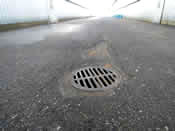
Stormwater manhole between poultry barns
Valve boxes and chambers are small in-ground structures that house one or more valves in a piping system.
Because of a lack of oxygen, workers have lost their lives in these small chambers. Wastewater containing organic matter can remain in valve boxes long enough to ferment. Fermented liquids may also leak into the box from pumps, valves, or pipes, or seep from the surface. Fermentation gases are toxic and can quickly cause death when inhaled at high concentrations.
| Hazards | Hazardous work |
|
|
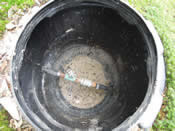
Valve chamber
Storage tanks often hold water used for the birds (poultry) to drink. Normally, hazardous gases won't be present in a water tank — provided the water is clean. However, a biofilm can form inside the tank. Some cleaning and disinfecting chemicals (including ozone and hypochlorites) can produce very toxic gases, even in small amounts.
Low-oxygen conditions can also occur if the tank has been empty for some time. The greatest risk is from drowning, which can occur in as little as 15 cm of water.
| Hazards | Hazardous work |
|
|
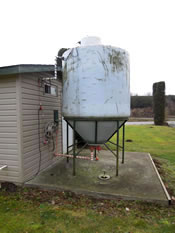
Water tank
A well pit is the chamber at the top of a wellhead. If the chamber is located under the floor of a building, it is considered a confined space. The well pit provides access to the well and pumping equipment. It also prevents freeze-up in the pressure tank and piping.
Normally, hazardous gases won't be present in a well, provided there's very little (or no) organic material in the water. However, oxygen can be depleted when metal rusts. This is most likely when the well pit is closed for a long time and condensation forms on metal surfaces.
| Hazards | Hazardous work |
|
|
 |
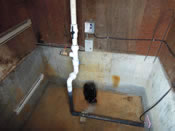 |
Well pits
Highlights
- New risk advisory on the dangers of fire and explosion in asphalt mix plants Published on: August 15, 2023
- New online tool helps workers and employers manage risk by delivering a custom list of health and safety resources Published on: December 05, 2022
- New slide show highlights the importance of protecting workers from the hazards of confined spaces in agriculture Published on: August 29, 2022

